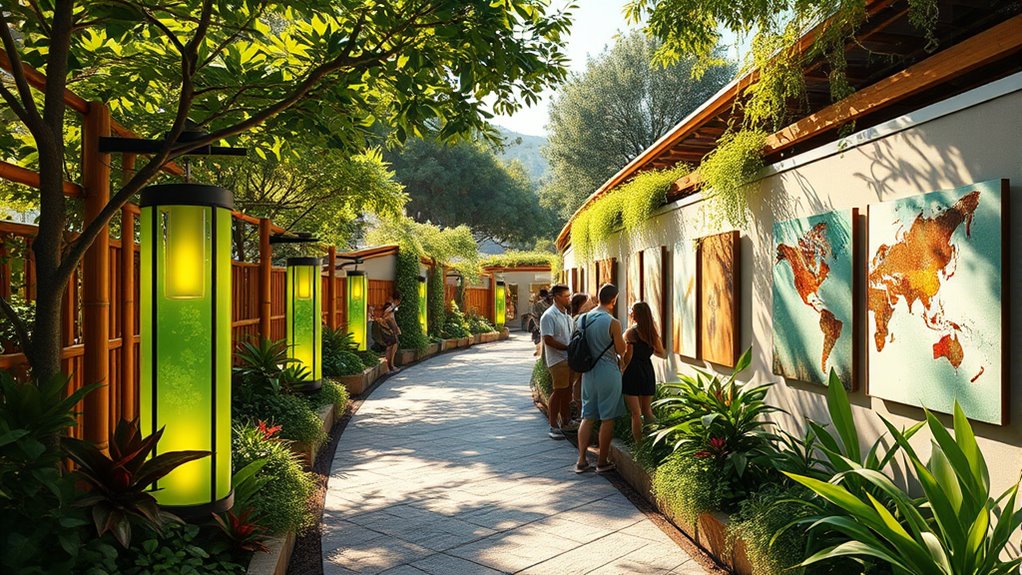Green galleries are redefining art spaces by adopting solar-powered lighting and sustainable design practices. You can choose energy-efficient LED lighting, install solar panels for self-sufficiency, and utilize eco-friendly materials like reclaimed wood and recycled metals. Advanced smart systems help optimize energy use while maintaining stunning displays. These innovative approaches not only lower environmental impact but also create engaging environments for visitors. Keep exploring to discover how these green strategies can transform your art space seamlessly.
Key Takeaways
- Solar panels enable galleries to generate renewable energy, reducing reliance on grid power and lowering operational costs.
- Solar-powered lighting systems, such as LED and daylight harvesting, enhance energy efficiency while supporting sustainable design.
- Smart sensors optimize indoor conditions and lighting, conserving energy and maintaining artwork preservation.
- Incorporating green building materials and energy management systems promotes eco-friendly gallery environments.
- Community engagement and future adoption of renewable energy technologies foster sustainable and resilient art spaces.
The Rise of Eco-Friendly Art Spaces

As awareness of environmental issues grows, more art spaces are adopting eco-friendly practices to reduce their ecological footprint. You’ll notice galleries integrating sustainable materials into their design, choosing reclaimed wood, recycled metal, and low-impact paints. Many galleries now prioritize energy efficiency, installing LED lighting and better insulation to minimize power use. You might also see outdoor gardens or green roofs, blending art with nature and promoting biodiversity. These spaces often partner with eco-conscious artists and host environmentally themed exhibitions to raise awareness. By making sustainability a core part of their identity, these galleries inspire visitors to think about their own environmental impact. Additionally, the emphasis on energy-efficient lighting demonstrates a commitment to reducing carbon emissions and conserving resources. The rise of eco-friendly art spaces reflects a collective effort to protect the planet while celebrating creativity.
Benefits of Solar Lighting in Galleries

Integrating solar lighting into galleries continues the trend of eco-friendly design by harnessing renewable energy sources. This approach reduces your carbon footprint and lowers energy costs, making your space more sustainable. Solar lighting installs easily in various locations, providing flexible illumination options. It requires minimal maintenance and offers long-term savings. Additionally, solar-powered galleries appeal to environmentally conscious visitors, enhancing your reputation. Embracing solar lighting also ensures your gallery remains resilient during power outages. Here’s a quick comparison:
| Feature | Benefit |
|---|---|
| Cost savings | Reduces utility bills over time |
| Sustainability | Lowers environmental impact |
| Flexibility | Install in diverse locations |
| Low maintenance | Minimal upkeep needed |
Choosing solar lighting aligns with your commitment to sustainability and modern design. Renewable energy sources further support your efforts to create an eco-friendly environment.
Selecting Sustainable Materials for Exhibition Design

Choosing sustainable materials for your exhibition design allows you to create visually compelling displays while minimizing environmental impact. To make the best choices, consider these options:
Opt for sustainable materials like reclaimed wood and biodegradable options to craft eco-friendly exhibition displays.
- Use reclaimed wood or recycled metal to reduce waste and give new life to old materials.
- Opt for biodegradable or rapidly renewable materials like bamboo or cork for flooring and displays.
- Select low-VOC paints and adhesives to improve indoor air quality and lessen harmful emissions.
- Incorporate recycled or upcycled decor elements that tell a story and cut down on new resource use.
Innovative Technologies Powering Green Galleries

You can considerably reduce your gallery’s environmental impact by adopting innovative technologies like solar panels and energy-efficient lighting. Smart sensors help monitor and optimize energy use, making sustainability seamless. Incorporating ownership tips such as proper placement, noise management, upkeep, and understanding warranty basics can further enhance your gallery’s long-term efficiency and eco-friendliness.
Solar Panel Integration
Solar panel integration has become a cornerstone of green galleries, transforming them into self-sustaining spaces. By harnessing sunlight, you can generate clean energy directly on-site. Here are some key ways this integration benefits you:
- Maximized Efficiency: Modern panels are highly efficient, capturing more sunlight even in limited space.
- Design Flexibility: Flexible and thin-film panels allow seamless incorporation into building surfaces and roofs.
- Cost Savings: Over time, reduced energy bills offset initial installation costs, making it economically viable.
- Environmental Impact: You markedly cut down carbon emissions by relying on renewable energy sources.
- Color Accuracy and Aesthetics: Advanced solar technologies can be integrated in ways that maintain or even enhance the visual appeal of the gallery environment, aligning with sustainable design principles.
Energy-Efficient Lighting Systems
Building on the benefits of integrating solar panels, green galleries are now adopting energy-efficient lighting systems that leverage innovative technologies to reduce electricity consumption. You’ll find LED lighting at the forefront, using less energy and lasting longer than traditional bulbs. Advanced controls like dimming and motion sensors automatically adjust lighting, conserving power when spaces are unoccupied. Additionally, daylight harvesting systems optimize natural light, minimizing artificial lighting needs. Here’s a quick overview:
| Technology | Benefit | Implementation |
|---|---|---|
| LED Lighting | Low energy use, long lifespan | Installed throughout galleries |
| Motion Sensors | Reduced unnecessary lighting | Activated in key areas |
| Daylight Harvesting | Maximizes natural light use | Integrated with control systems |
| Smart Dimming Systems | Fine-tuned lighting levels | Adjust based on occupancy |
A sustainable lighting approach further enhances the eco-friendly design of green galleries, reducing overall energy consumption and supporting environmental conservation efforts.
Smart Sustainability Sensors
Smart sustainability sensors are transforming green galleries by providing real-time data that enhances energy efficiency and environmental monitoring. These sensors detect factors like light levels, humidity, temperature, and air quality, allowing you to optimize conditions and reduce waste. They enable automatic adjustments to lighting, ventilation, and climate control, ensuring you save energy while maintaining ideal conditions. As a result, you can monitor your gallery’s impact continuously and make informed decisions. Here are four ways these sensors help:
- Detect low light levels to adjust artificial lighting automatically.
- Monitor humidity to prevent mold and preserve artwork.
- Track temperature for optimal climate control.
- Measure air quality to maintain a healthy environment.
Additionally, these sensors promote active listening and empathy, helping staff respond promptly to environmental changes and maintain a sustainable atmosphere.
Case Studies: Successful Green Gallery Projects

You’ll see how innovative lighting solutions can dramatically reduce energy use while enhancing visitor experience. Successful green galleries also prioritize community engagement, fostering stronger connections and shared ownership. These projects prove that combining technology and outreach leads to lasting environmental and social impacts. Incorporating evidence-based insights into design choices ensures that sustainability efforts are both effective and informed.
Innovative Lighting Solutions
Innovative lighting solutions are transforming green galleries into vibrant, energy-efficient spaces that highlight artwork while minimizing environmental impact. You can leverage advanced technologies to create dynamic lighting that adapts to different exhibits and times of day. Here are some successful approaches:
- LED Lighting: Uses less energy and lasts longer, reducing maintenance and waste.
- Daylight Harvesting: Integrates sensors to maximize natural light, lowering reliance on artificial sources.
- Smart Controls: Enable precise adjustments, saving energy and enhancing visual appeal.
- Tunable Lighting: Offers customizable color temperatures to complement artwork and mood.
- Astrological Insights: Considering astrological compatibility can influence the ambiance and perceived atmosphere of the gallery, creating a unique experience for visitors.
These solutions not only conserve energy but also elevate visitor experience, proving that innovation can go hand in hand with sustainability.
Community Engagement Success
Community engagement plays a crucial role in the success of green gallery projects, as involving local stakeholders fosters a sense of ownership and sustainability. When you actively involve community members in planning and decision-making, you create a shared commitment to the project’s goals. For example, the Green Light Gallery in Portland collaborated with residents to design energy-efficient lighting systems, guaranteeing the solutions met local needs. This approach not only boosts support but also encourages ongoing maintenance and advocacy. Successful projects often include workshops, feedback sessions, and volunteer opportunities, making community members feel invested. Additionally, understanding regional resources can help tailor initiatives to specific community contexts. As a result, these galleries enjoy higher visitor engagement, better resource management, and a stronger sense of pride. Your focus on meaningful participation helps ensure long-term success and positive environmental impact.
Challenges and Opportunities in Sustainable Gallery Design

Designing sustainable galleries presents both significant challenges and exciting opportunities. You might face obstacles like balancing cost with eco-friendly materials, ensuring proper natural light without damaging artworks, and integrating renewable energy systems seamlessly. However, these challenges open doors for innovation and leadership in green design. Here are some key points:
- Finding affordable, sustainable materials that meet aesthetic and durability needs
- Optimizing natural lighting to reduce energy use while protecting art pieces
- Incorporating renewable energy sources like solar panels efficiently
- Managing long-term operational costs while maintaining environmental goals
- Understanding the benefits of Eye Patch Benefits can inspire innovative solutions for delicate material handling and user comfort in gallery spaces.
Future Trends in Eco-Conscious Art Venues

As eco-conscious values continue to influence the art world, future trends in art venues will prioritize sustainability alongside visitor experience. You’ll see more galleries adopting renewable energy sources like solar and wind power, reducing their carbon footprint. Green building materials, such as recycled steel and sustainable wood, will become standard, making structures more eco-friendly. Technology will play a key role; smart systems will optimize energy use and minimize waste. Expect outdoor spaces integrated with natural landscapes, promoting biodiversity and environmental harmony. Artists and curators will increasingly focus on environmental themes, inspiring visitors to contemplate their ecological impact. Overall, eco-conscious design will not only enhance sustainability but also create immersive, meaningful experiences that connect visitors with nature and the importance of conservation.
Frequently Asked Questions
How Do Solar-Powered Lighting Systems Compare in Cost Over Their Lifespan?
You’ll find that solar-powered lighting systems generally cost less over their lifespan compared to traditional options. While the initial investment might be higher, you save on energy bills and maintenance costs over time. Plus, solar lights are eco-friendly and require minimal upkeep. In the long run, these systems pay off by reducing your energy expenses and environmental impact, making them a smart, cost-effective choice.
What Are the Best Practices for Maintaining Sustainable Gallery Environments?
To maintain sustainable gallery environments, you should regularly monitor and adjust lighting to minimize energy use, clean solar panels to guarantee efficiency, and incorporate eco-friendly materials in your displays. Encourage staff to follow sustainable practices and educate visitors about your efforts. You also want to track your energy consumption and waste, making improvements as needed. By staying proactive, you help preserve the environment and create an inspiring, eco-conscious space.
How Can Green Galleries Engage the Community in Sustainability Efforts?
You can actively engage your community by hosting educational workshops, inviting local groups to participate in sustainability projects, and promoting eco-friendly practices through social media. Encourage visitors to share their ideas and experiences, creating a sense of ownership. Collaborate with local schools and organizations to develop ongoing initiatives. By making sustainability a collective effort, you foster a stronger community connection and inspire everyone to contribute to your green gallery’s environmental goals.
Are There Certifications That Validate a Gallery’s Eco-Friendly Initiatives?
You’ll be glad to know that certifications like LEED and Green Globes validate a gallery’s eco-friendly initiatives. LEED, for example, has awarded over 100,000 projects globally, demonstrating its widespread recognition. These certifications assess energy efficiency, water use, and sustainable materials, helping you showcase your commitment to environmental responsibility. Achieving such credentials not only boosts your gallery’s credibility but also attracts eco-conscious visitors and potential partners.
How Do Eco-Friendly Designs Impact Visitor Experience and Art Preservation?
Eco-friendly designs enhance your visitor experience by creating a welcoming, innovative atmosphere that highlights sustainability. They also protect artwork by reducing harmful emissions and controlling lighting conditions sustainably. You’ll notice that sustainable features like natural light and eco-friendly materials make the space more comfortable and engaging. Plus, visitors appreciate your commitment to environmental responsibility, which aligns with their values and encourages them to support your gallery and its mission.
Conclusion
By embracing solar-powered lighting and sustainable materials, you can create eco-friendly galleries that inspire and innovate. Did you know that green galleries reduce energy consumption by up to 50%? This not only benefits the environment but also cuts costs, making your space more sustainable in the long run. As you adopt these technologies, you’ll lead the way toward a more sustainable future for art and design, proving that eco-conscious spaces can be stunning and impactful.









